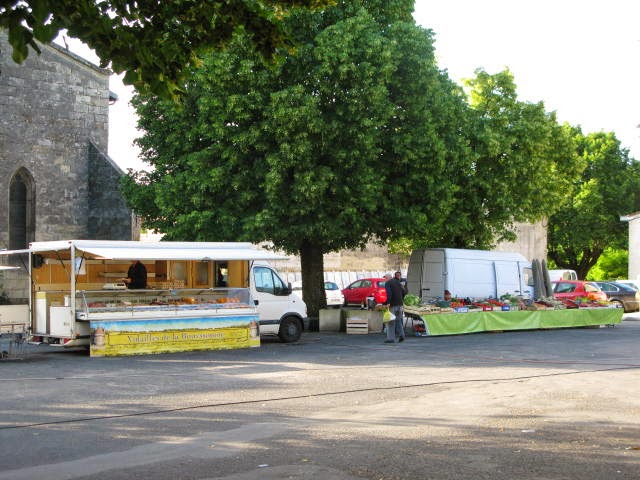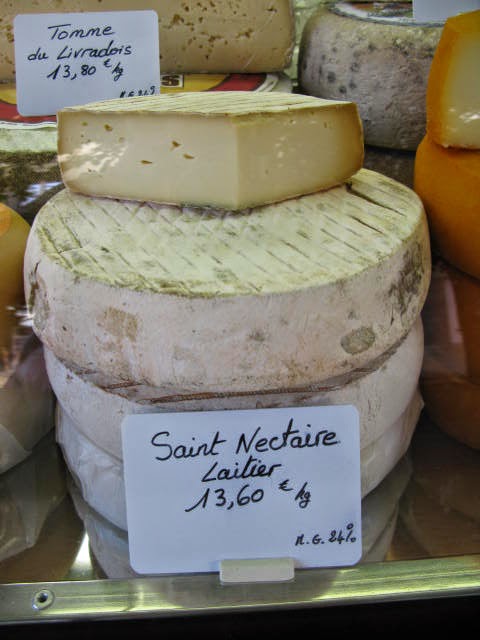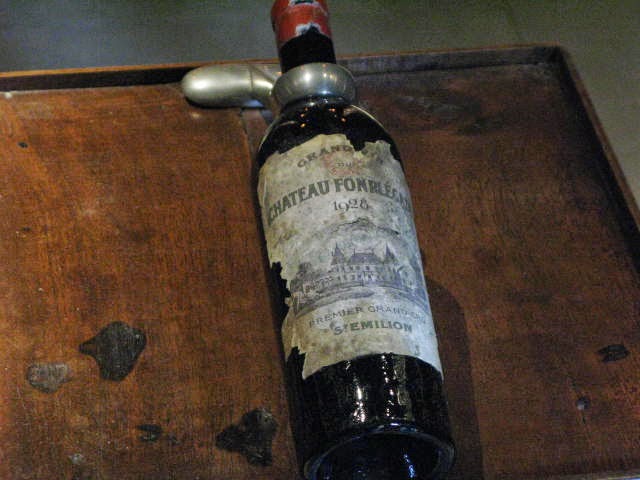Bonjour tout le monde! Je suis votre
blogueur convivial. Hello,
everybody. I’m your friendly
blogger. Welcome back to Cépage et Cuisine, Mary’s
and Brian’s wine and food blog. Today we’re
exploring the area near our gite in
the commune of Montagne and nearby Saint-Christophe-des-Bardes and Saint
Émilion.
We
started the day by driving to the nearby town of Lussac where we heard there
would be a farmer’s market today. There
was, in fact, a market but nothing at all like the Beaune market. It was a tiny market of a few vendors on Place de la République, the town plaza
next to the church.
It was
actually very pretty and very nice. We
were among the first to arrive when it opened at 8:00 a.m. It was quiet, the vendors were having
conversation, very laid back.
The Beaune
market is great fun with the crowds and variety, but this nice, small, laid
back atmosphere was also fun. Mary liked
it because she could stroll up to the vendor and browse the selection without
having to jostle elbow to elbow.
We picked
up some meat, vegetables, fruit, and cheese for dinner in the gite later.
After the
market experience, we passed through Montagne so you know what that means … yes,
the boulangerie. Mary was with me today
so she could choose for herself.
Chocolatine, it is.
While
jogging a couple of days ago I passed by a nearby estate, Clos de la
Barbanne. The vigneron was working in his vineyard and greeted me in French, then
asked a question of some sort. I gave
him my standard reply, “Je parle en peu
le Francais,” I speak only a little French.
So he said, “How are you? Are you
doing ok?” We had a nice laugh.
I stopped at their gate on the way back and his wife invited us to visit them and tour the estate.
I stopped at their gate on the way back and his wife invited us to visit them and tour the estate.
We walked
over this morning, all of perhaps 5 minutes from the gite to Clos de la Barbanne.
Here’s a great photo of the gite
and Château Lys de Maisonneuve I snapped during the walk. I mentioned in a previous post that the gite is part of a working wine
estate. Here you can see the gite, which is the two buildings next to
our car. The rest of it is the
winery. You can also see how it is
completely surrounded by vineyards. It’s
just a beautiful location.
Clos de
la Barbanne is a wine estate that is tiny by Bordeaux standards, only 1.7
hectares, less than 4.5 acres.
Originally from Alsace, Laurent and Annie Gerber settled here a few
years ago after Laurent left a career in agribusiness, including living in
Illinois and Iowa. Laurent is the vigneron and Annie manages their
luxurious bed and breakfast.
Laurent
walked us through his vineyards and gave us an excellent history of the area
and viticulture. For example, we’ve seen
these yellowed vines frequently on our travels.
Laurent explained that the soils in his vineyard are mostly clay and
limestone. When the limestone is very
near the surface, the vines are less able to extract necessary phosphorus and
potassium from the soil, so they turn this yellow color. He manages this problem simply by applying a
spray of phosphorus and potassium that is absorbed through the leaves. He said the foilage turns green again
practically overnight.
Here you
can see that Laurent turns the soil in every other row, leaving a cover crop in
alternate rows to promote biodiversity.
This
beautiful view from Laurent’s vineyard shows a line of trees where the tiny La
Barbanne flows. That white gate on this
side of the trees is the entrance to our gite. Saint-Christophe-des-Bardes is up the hill on
the other side of the La Barbanne. That
little river is the border between the communes of Saint-Christophe and
Montagne. Likewise, it is the border
between two Saint Émilion satellite appellations. They are Saint-Christophe-des-Bardes-Saint
Émilion and Montagne-Saint Émilion.
Perhaps because it is just that much closer to Saint Émilion, the
vineyards in Saint-Christophe, seen here just on the other side of those trees, are sharply more expensive. A hectare of
vineyard property over there is around €125,000 in contrast to about €80,000 on
the Montagne side. That’s about $175,000
per acre vs $110,000.
After the
vineyard tour, Laurent took us to the chai,
the small winery where he makes and ages his wine. His production is small,
only about 500 cases per year.
Here’s his wine press. Unlike other producers where these are shown to visitors as antiques that are no longer used, Laurent still presses grapes with this one.
Laurent
opened a bottle of his wine, which carries the proprietary name, Concerto. It is 90% Merlot and 10% Cabernet Franc. Annie served a small lunch and we enjoyed
conversation about their experience in the U.S. and France and their family. The wine was delicious, fruit-forward with
dark berry and plum and a round, velvety texture. It would be great on its own and with food.
Our
tasting appointment for the afternoon was Château Fonplégade in Saint
Émilion. We enjoyed a bottle from there
years ago. The tour and tasting was
recommended to us by the owner of Les Marronniers. It looks like the quintessential Bordeaux
château, big, elegant, imposing. The construction work on the right is to build the second tower. The original 18th century plans included two towers, but only the left tower was constructed until now.
This is the room where we met our guide, Amy.
Not too many grand pianos when we taste in Burgundy. Back in the small villages of the côte like Savigny-les-Beaune, it’s more likely to be an upturned empty barrel in the cellar.
Before we started our tour, Amy offered us a glass of the Château Fonplégade Fleur de Fonplégade rosé, a cool, refreshing quaff on a warm day.
Château
Fonplégade was acquired several years ago by new owners who happen to be
American. The winery facilities were
completely updated with new equipment and technology, including these massive
oak fermentation vats. The château is
also being renovated as you can see in the exterior photo above.
Similar
to what we’ve seen at some other châteaux, the vats have stainless steel coils
that circulate water to control the fermentation temperature.
Here’s a high-tech, computer-controlled grape press. It’s a far cry from the hand-cranked wooden press at a small estate such as Clos de la Barbanne.
Château
Fonplégade has several of the concrete eggs for maturing wine. As I mentioned in the post about Château
Brown, the shape of the egg and the earth’s rotation create a vortex that keep
the grape skins and other solids in motion inside the egg. As a result, the wine extraction is improved
without manual stirring. The porosity of
the concrete allows a tiny exchange of oxygen, similar to what might be
obtained with oak barrels.
A control
panel regulates the temperature in the cellars and barrel rooms.
Outside
the château, on the sloping hillside of clay and limestone where the merlot is
planted, is this ancient fountain, originally built by the Romans over a
natural spring that continues to flow.
To my
delight, Amy opened the 2004 Château Fonplégade for us to taste. Generally, the most recent vintage is what is
poured for tastings at domaines and châteaux.
Every once in a while, we’re fortunate to get to taste a mature wine. This one is almost 10 years old! Of the four wines we tasted, two from another
château with the same owners, and a second label wine called Fleur de Fonplégade,
the Château Fonplégade was the clear winner.
It is 95% Merlot and 5% Cabernet Franc with a wonderful perfume of red
and dark fruit, a fleshy mouthfeel with flavors of berries, dark cherry, and
plum along with savory herbs, but also enough tannic backbone and acidity for
good balance. This would be a wonderful
wine to enjoy with a hearty dinner of grilled steak, roasted meats, or even a
great weeknight meatloaf with mac & cheese.
It so
happens that the American owners import their own wine to a warehouse in Napa,
so it is possible to buy the wine in Saint Émilion and have it shipped at
domestic rates from Napa. We bought
several bottles to enjoy back at home.
Mary cooked
the saucisses et légumes we got
earlier in the day at the Lussac market.
Along with a little cheese and fruit and a bottle of the rosé from Château
Fonplégade, it was a simple and delicious end to a very nice day. An interesting aspect was the American
connection. We Americans visited Annie
and Laurent, the proprietors at Clos de la Barbanne who lived in the U.S. for
several years, then spent the afternoon at Château Fonplégade, owned by
Americans.
That’s our post for
today. We hope you enjoyed it. Thanks so much for reading us. Tomorrow will be our last day in France, so
we still have more to share. Keep
checking back at Cépage et
Cuisine as we wrap up our wine, food, and cultural vacation
in Bordeaux. In the meantime,
Cheers!
Mary♥Brian







































Great blog post!
ReplyDelete